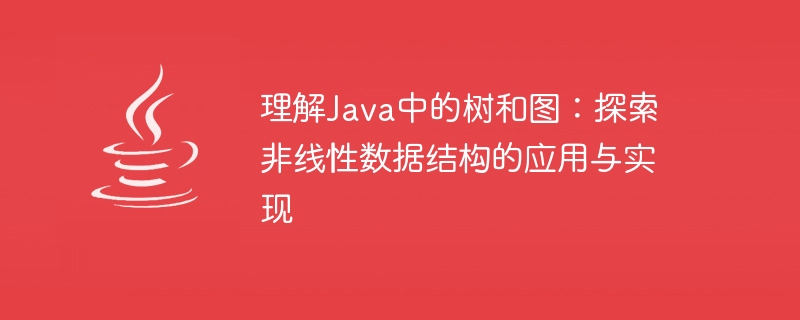深入探索Java中樹和圖的非線性資料結構應用和實作方法
- 王林原創
- 2023-12-26 10:22:091076瀏覽

理解Java中的樹與圖:探索非線性資料結構的應用與實作
- 引言
在電腦科學中,資料結構是電腦中儲存、組織和管理資料的方式。資料結構可分為線性資料結構和非線性資料結構。樹和圖是非線性資料結構中最常用的兩種類型。本文將重點放在Java中樹和圖的概念、應用和實現,並給出具體的程式碼範例。 - 樹的概念與應用程式
樹是一種抽象資料類型,由節點和邊組成的集合。樹的每個節點包含一個資料元素和指向其他節點的指標。樹的一個特殊節點稱為根節點,它沒有父節點,其他節點都有一個父節點和零個或多個子節點。樹的一個重要應用是搜尋和排序。例如,二元搜尋樹就是一種常用的樹狀結構,它可以在O(log n)的時間複雜度內尋找、插入和刪除元素。以下是一個簡單的二元搜尋樹的Java實作範例:
class Node {
int data;
Node left;
Node right;
public Node(int item) {
data = item;
left = right = null;
}
}
class BinarySearchTree {
Node root;
public BinarySearchTree() {
root = null;
}
public void insert(int data) {
root = insertRec(root, data);
}
private Node insertRec(Node root, int data) {
if (root == null) {
root = new Node(data);
return root;
}
if (data < root.data)
root.left = insertRec(root.left, data);
else if (data > root.data)
root.right = insertRec(root.right, data);
return root;
}
public boolean search(int data) {
return searchRec(root, data);
}
private boolean searchRec(Node root, int data) {
if (root == null)
return false;
if (data == root.data)
return true;
if (data < root.data)
return searchRec(root.left, data);
return searchRec(root.right, data);
}
}
public class Main {
public static void main(String[] args) {
BinarySearchTree bst = new BinarySearchTree();
bst.insert(50);
bst.insert(30);
bst.insert(70);
bst.insert(20);
bst.insert(40);
bst.insert(60);
bst.insert(80);
System.out.println("Is 20 present? " + bst.search(20));
System.out.println("Is 100 present? " + bst.search(100));
}
}在上面的範例中,我們定義了一個Node類別來表示二元樹的節點,以及BinarySearchTree類別來表示二元搜尋樹。我們可以使用insert方法向樹中插入元素,使用search方法來搜尋元素。
- 圖的概念與應用
圖是一種由節點和邊組成的集合,節點表示圖中的元素,邊表示節點之間的連結關係。圖的一個重要應用是表示網絡和關係。例如,在社交網路中,使用者可以表示為節點,他們之間的關注和好友關係可以表示為邊。下面是一個簡單的圖的Java實作範例:
import java.util.*;
class Graph {
private int V;
private LinkedList<Integer>[] adjList;
public Graph(int v) {
V = v;
adjList = new LinkedList[v];
for (int i = 0; i < v; ++i)
adjList[i] = new LinkedList();
}
void addEdge(int v, int w) {
adjList[v].add(w);
}
void BFS(int s) {
boolean[] visited = new boolean[V];
LinkedList<Integer> queue = new LinkedList<Integer>();
visited[s] = true;
queue.add(s);
while (queue.size() != 0) {
s = queue.poll();
System.out.print(s + " ");
Iterator<Integer> i = adjList[s].listIterator();
while (i.hasNext()) {
int n = i.next();
if (!visited[n]) {
visited[n] = true;
queue.add(n);
}
}
}
}
}
public class Main {
public static void main(String args[]) {
Graph g = new Graph(4);
g.addEdge(0, 1);
g.addEdge(0, 2);
g.addEdge(1, 2);
g.addEdge(2, 0);
g.addEdge(2, 3);
g.addEdge(3, 3);
System.out.println("BFS traversal starting from vertex 2:");
g.BFS(2);
}
}在上述範例中,我們使用鄰接鍊錶來表示圖的資料結構。我們定義了Graph類,其中addEdge方法用於添加邊,BFS方法用於進行廣度優先搜尋遍歷。在範例中,我們從頂點2開始進行BFS遍歷,並列印出遍歷順序。
- 結論
本文介紹了Java中樹和圖的概念、應用和實作方法,並給出了具體的程式碼範例。樹和圖是非線性資料結構中常用的類型,它們在計算機科學中有廣泛的應用。透過掌握樹和圖的基本概念和實作方法,可以更好地理解和處理非線性資料結構,並應用於解決實際問題。
以上是深入探索Java中樹和圖的非線性資料結構應用和實作方法的詳細內容。更多資訊請關注PHP中文網其他相關文章!
陳述:
本文內容由網友自願投稿,版權歸原作者所有。本站不承擔相應的法律責任。如發現涉嫌抄襲或侵權的內容,請聯絡admin@php.cn
上一篇:深入了解Java技術的核心原理下一篇:深入了解Java技術的核心原理

